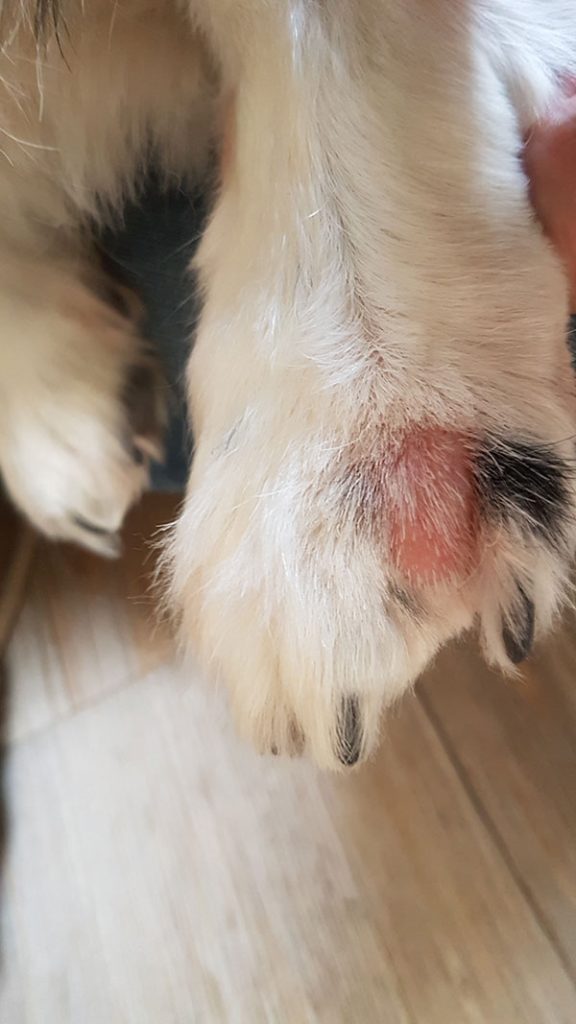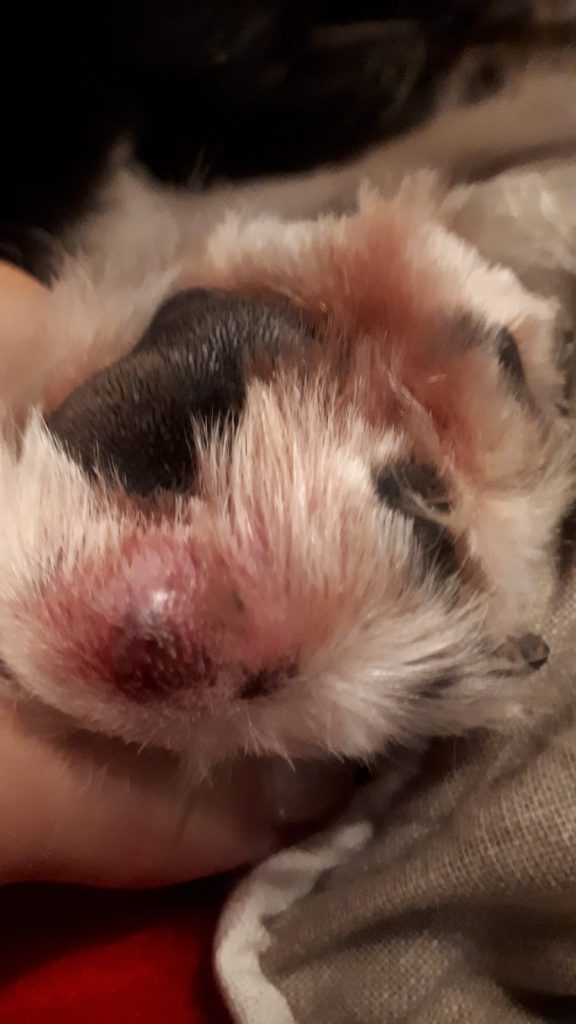Medical history
Piper is a 7-year-old Australian Shepherd (allegedly purebred), female, not neutered. As a puppy, she had difficulty walking due to orthopaedic problems, so she regularly had swim training. At the age of one year, the skin between the toes of her right foreleg cracked. The veterinarian believed it was an abscess, treated it accordingly, it healed, but then tore again immediately. It then spread to all paws, the dog got dog shoes, which solved the problem. After 1.5 years, the dog walked on gravel without shoes and the skin cracked again and from that point on could not be controlled anymore. The veterinarian treated with Enrofloxacin and laser, it healed, but tore again right away (Fig. 1).
Living habits: There are 4 dogs in the household. They live in the flat and the garden.
Food: The dog is fed a BARF diet.
Dog’s digestion: no abnormality detected, she defecates 2 – 3x a day.
Clinical examination
Clinically, a brown discolouration on all 4 paws, interdigital, palmar and plantar, was seen during the initial examination (according to the owner, the dog licks after taking off the shoes). An opened fistula tract was found between the toes. The cytological examination revealed neutrophil granulocytes, a few cocci, but no Malassezia.
Differential diagnoses: Food allergy, atopic dermatitis, secondary infections
Treatment: Bathing with Chlorhexidine shampoo once a day and an elimination diet with salmon and sweet potatoes, self-prepared, then followed by provocation diets with various carbohydrates, proteins and mineral blends. The elimination diet was carried out for 2 months. After this, a plan was drawn up in which every 2 weeks a new substance should be used to trigger a reaction. If symptoms were to recur, the original diet should be resumed until the lesions had healed, and then the next provocation should be started.
The owner came back after more than half a year saying that there had not been any symptoms for 7.5 months. However, when she tried a new vitamin mix, the problems on the paws flared up again. According to the owner, Piper tolerated rabbit meat and sweet potatoes best, so she should stick to this diet. An allergy test – carried out by the veterinarian – confirmed the tolerability of rabbit, sweet potato and parsnip (IgE and IgG reaction class 0). In the following years, relapses occurred repeatedly as a result of experiments or accidental food intake. Often, a blood blister was visible between the toes (note: among the author’s clientele, this frequently happens to patients suffering from food allergy), which burst after some time. Once, it was a piece of horse head meat, or different oils that led to the relapse, all mineral blends that were tested failed, and even flavoured antibiotics took their toll. The owner kept a very regular food diary throughout this time so that conclusions could be drawn regarding the cause of the relapse. She also learnt how to use a cortisone spray to stop a relapse before the clinical picture would escalate completely (Fig. 2).
Discussion
Food allergy prevalence is up to 25% in animals with skin diseases, pruritus or allergic disorders. Thus, in dogs with pruritus or other allergic signs, an elimination-provocation diet is always indicated to exclude a food-induced allergy (Olivry and Müller, 2017). There is no age limit for this disease, which means that very young or even old animals can be affected for the first time. Clinically, there may be dermatological or gastrointestinal signs or a combination of both.
In our case, the dog was one year old at the onset of the symptoms, and the symptoms were strictly limited to the paws. The diagnosis is based on the medical history and the clinical dermatological examination, the exclusion of all differential diagnoses and the disappearance of signs when feeding an elimination diet (“gold standard”), then followed by a relapse of symptoms when feeding a provocation diet with the previously fed food or a component thereof. An allergy diagnosis is always a clinical diagnosis! An allergy test is performed to select allergens for an elimination diet (a protein and a carbohydrate with reaction class 0). Piper reacted to a variety of provocations (partly intentionally, partly unaware) and only ever showed significant improvement of symptoms when being fed with rabbit, which had been tested negative in the food allergy test, in combination with sweet potato or parsnip.
-
Fig. 1: Case study – Food allergy
Picture: Regina Wagner
-
Fig. 2: Case study – Food allergy
Picture: Regina Wagner
- Tab. 1: Food allergens basic and extended
Laboklin offers food allergy tests for the detection of allergen-specific antibodies (IgE and IgG) to various food components. The serological allergy test identifies those allergens to which antibodies have been formed (allergen-specific IgE and IgG antibodies to various food components, ELISA). In addition to the “basic” food allergy test, we have also been offering an “extended” and a new “exotic” food allergy test for some time now. This enables you to specifically test these components and then use them for the self-prepared as well as the commercial elimination diet (Tab. 1).
The group of Prof. Dr. Ralf Müller presented a study of the Small Animal Clinic of the University of Munich which showed that the negative predictive value of this test is 81.1% when both antibodies (IgE and IgG) are taken into account (Bethlehem et al., 2012). This means that by feeding food components that tested negative in both antibody classes, the correct elimination diet is used in 4 out of 5 dogs.
This also confirms that food-specific antibodies are useful for selecting the components of an elimination diet due to their high negative predictive value. The owner’s compliance with carrying out the diet is greatly enhanced by a positive test result, specific nutritional suggestions based on it.





